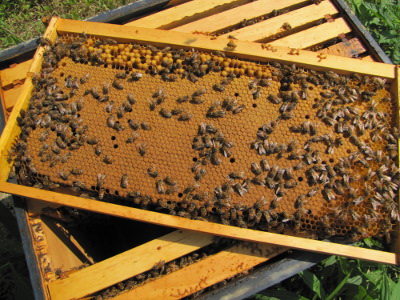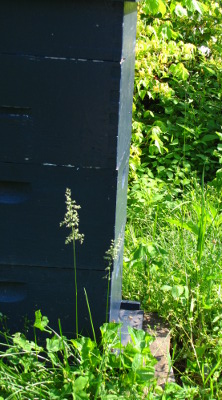
Hive split success
 Our
easy hive split
was a buzzing success! Both the mother and the daughter hive have
had workers flying in and out extremely busily all month, but that
doesn't really mean anything. If my hive split had failed
(meaning the queenless hive didn't manage to requeen), workers would
still go out and harvest nectar and pollen until they eventually got
picked off by predators and weren't refreshed by new bees.
Instead, I had to wait (very impatiently) for a full month and then
delve into each brood box to see what was going on down there.
Our
easy hive split
was a buzzing success! Both the mother and the daughter hive have
had workers flying in and out extremely busily all month, but that
doesn't really mean anything. If my hive split had failed
(meaning the queenless hive didn't manage to requeen), workers would
still go out and harvest nectar and pollen until they eventually got
picked off by predators and weren't refreshed by new bees.
Instead, I had to wait (very impatiently) for a full month and then
delve into each brood box to see what was going on down there.
In order to understand
the story, you have to know that each type of bee in the hive develops
along a slightly different timeline:
| Egg
(days) |
Larva
(days) |
Pupa
(days) |
Total
days |
|
| Worker |
3 |
5.5 |
12.5 |
21 |
| Queen |
3 |
5 |
8 |
16 |
| Drone |
3 |
6.5 |
14.5 |
24 |
Queens rush through their childhood and chew out of their capping within 16 days, but workers take three full weeks to mature. I checked on the bees exactly 28 days after the split and this is what I saw:
- East hive --- Small
larvae (probably no more than two or three days in the larval stage)
and eggs. (No photo because the bees got pissy.)
- Middle hive --- Lots of
capped brood, larvae, and eggs. (One frame shown above.)
 Clearly, during my hive
split, I transferred the queen to the middle
hive, and she just kept plugging away at her duties (laying eggs),
which resulted in the current state with brood of all ages. In
contrast, the east hive had lost their queen, so they didn't do any
child-rearing until less than a week ago. That lines up very well
with the amount of time it would take for a queen to hatch (16 days),
mate (another few days, potentially more because of the constant rain),
and then lay the eggs that turned into the largest larvae present
(about 6 days old) --- 22 days plus whatever time her mating flight
took.
Clearly, during my hive
split, I transferred the queen to the middle
hive, and she just kept plugging away at her duties (laying eggs),
which resulted in the current state with brood of all ages. In
contrast, the east hive had lost their queen, so they didn't do any
child-rearing until less than a week ago. That lines up very well
with the amount of time it would take for a queen to hatch (16 days),
mate (another few days, potentially more because of the constant rain),
and then lay the eggs that turned into the largest larvae present
(about 6 days old) --- 22 days plus whatever time her mating flight
took.There's still a very slight chance that the new queen could have mated badly and is laying drones --- I'll know for sure next week when I see capped brood. And an even slighter chance that the eggs are being laid by workers --- unlikely since the brood pattern is so even and the eggs are in the bottom of the cells rather than on the sides. But I'm pretty confident the hive split was a success.
Since I was down so deep in the hives, I went ahead and checkerboarded both brood boxes so that the excess honey wouldn't tenpt the bees to swarm. The bees were not pleased with this intrusion, and I had to don my gloves after one stung my hand. After I know for sure that the east hive has a happy queen, I'll leave the brood box alone and focus on honey for the rest of the summer....
Want more in-depth information? Browse through our books.
Or explore more posts by date or by subject.
About us: Anna Hess and Mark Hamilton spent over a decade living self-sufficiently in the mountains of Virginia before moving north to start over from scratch in the foothills of Ohio. They've experimented with permaculture, no-till gardening, trailersteading, home-based microbusinesses and much more, writing about their adventures in both blogs and books.
Want to be notified when new comments are posted on this page? Click on the RSS button after you add a comment to subscribe to the comment feed, or simply check the box beside "email replies to me" while writing your comment.
RSS
comment 1
Ooo, I can hardly wait to have bees. So much yummy food yield for relatively little work.
Comment by
Emily
— Wed Jun 1 14:53:03 2011
- Remove comment
Easy bees
They felt a bit overwhelming the first year because there was just so much to learn, but now I totally agree with you. I figure the bees take at most an hour per week, which includes the big honey harvest. And now that I know I can propagate them nearly as easily as splitting a hunk of comfrey, they feel much more sustainable.
Comment by
anna
— Wed Jun 1 15:19:07 2011
- Remove comment
Nice little chart!
No, really!
Comment by
Dean
— Wed Jun 1 17:40:47 2011
- Remove comment
Bee development chart
I hope it's not too obvious that I wrote the post around the chart. It's been burning a hole in my virtual pocket for years! 

Comment by
anna
— Wed Jun 1 20:17:54 2011
- Remove comment
Add a comment
